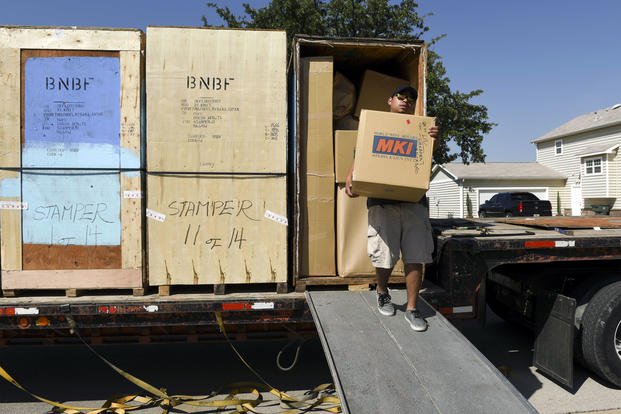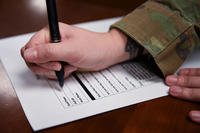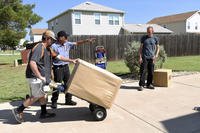When it comes to PCSing, figuring out what you need to do can be intimidating. It can be difficult to know where to start, what steps are actually required and what things are mere suggestions or just best practice.
This master checklist can help you walk through each stage of your military move process to guide you through mastering your PCS, not just surviving it. And while whether you need each step will depend on where or how you are moving, this comprehensive military PCS checklist tool will make sure you make it to the other side of your military move with your sanity intact.
PCS Checklist: The Initial Process
- Make a move announcement -- This one is all about personal preference. Some families love an elaborate PCS announcement to tell their friends and family, while others tend to keep it quiet and only tell specific people. Whichever way you decide, keep in mind operational security (OPSEC) and personal security (PERSEC) when posting publicly on social media channels.
- Tell your kids -- If you have children, you'll want to begin thinking about how to tell them about the upcoming move. As a parent, you know your children best and whether they function better with advance notice or need less time to dwell on the inevitable changes.
- Decide the method of PCSing -- Depending on where you are moving, you will have a choice to make on what type of move you want to do and what shipments you want to utilize. For example, moves outside the continental U.S. (OCONUS) can be eligible for non-temporary storage (NTS), unaccompanied baggage (UAB) and household goods (HHG) while those inside the continental U.S. (CONUS) is just HHG. And you have to choose if you want the military to handle moving coordination or if you want to move yourselves (CONUS only). Deciding these now can help speed up the process later.
- Check local installation for PCS briefs -- Check your installation's family support office for any offered briefs or classes that will go into detail on the process and your entitlements so you can be more prepared for your move.
- Start organizing a PCS binder -- You're going to want a PCS binder or a system for organizing all the PCS paperwork. That includes everything from copies of your orders and leave forms to move-out checklists, inventory forms and other documents that are needed along the way. Creating an organizing system from the beginning will come in handy when you need to access those documents.
- Create a PCS budget -- After you have taken a PCS briefing class and understand your entitlements and potential expenses, it is the perfect time to create a PCS budget. Doing so will help you identify what expenses you will need to cover out of pocket or upfront, and what expenses may be reimbursed. It will also help you identify what money you may need to save. Your local finance center or service relief organization can help you create a budget.
- Check your insurance -- It is always important to check your insurance coverage when planning to move. Your policy should cover your items in storage and in transit. If you are selling your home, you'll need to look at what extensions your policy offers or look into a private personal property policy to cover the gap before arriving at your new home. Keep in mind that the transportation service provider (TSP) is only responsible for $6 per pound up to $75,000. If replacing everything in your shipment costs more than that, then you need a private policy.
Starting the Process: PCS Checklist
- Get your official orders -- While you can begin house-searching, gathering information on your upcoming area and securing tourist passports if needed, you cannot do anything on the military side without your official orders. There is no scheduling of your household goods, UAB and NTS shipments, no fee passports, flights, OCONUS personal vehicle (POV) shipping or storage or Exceptional Family Member Program (EFMP) paperwork without them. Everything regarding official movement and travel will be on hold until the official orders are issued. Once you have them in hand, you should get your move set up on DPS immediately.
- Set up you move on the Defense Personal Property System (DPS) through Military OneSource -- As soon as you receive your official orders, you should officially set up your move:
- If your move is within 14 days of receiving your orders, you need to also contact your local transportation office to ensure they have all the documents and to let them know of the short timeframe.
- If it is your first or last PCS, you need to visit the local transportation office in person to set up your move.
- You do not need an address to set up your move. Instead, input your gaining location. You can update with an address when you receive one.
- If you are authorized for multiple shipments (HHG, UAB, NTS), you will set up a separate shipment for each one. If you are planning to do a partial personally procured move (PPM) in conjunction with an HHG shipment, you will need to set up a second shipment as a PPM as well.
- Set up an appointment with the vehicle processing center (VPC) for vehicle shipping/storage. If you are going OCONUS and authorized a POV shipping or storage entitlement, you can set that up on www.pcsmypov.com. You will need to make an appointment at the VPC to drop off the vehicle and to ensure you have all the documents required, and that the vehicle is in the proper working condition required to ship or store the vehicle.
- Contact housing/landlord to notify of move-out date
- The Servicemembers Civil Relief Act (SCRA) requires a 30-day notice to move out with orders. Once you receive your orders you should verify your timeline and give written notice.
- Verify the amount of rent you will owe upon moving out.
- Verify your move-out checklist.
- Set up an appointment for no-fee passports if you have an OCONUS PCS where they are needed. While your tourist passports will allow you to travel, the no-fee passports are what allow you to live in the foreign country where you are assigned. Keep in mind there could be a delay in receiving them, so you should start this process as soon as possible.
- Start EFMP screening -- Service members are required to have EFMP updated and current as part of the orders process. If you are going OCONUS, all family members will be required to undergo an EFMP screening to ensure the gaining location has the medical/educational services needed to support the family.
- Book flights -- If you are traveling OCONUS, you will need to stop by the travel office on your installation to have them booked through the military's travel system known as SATO. You will be issued an itinerary but will not be ticketed until closer to your departure date. If you have pets and are flying the military rotator, you will need to make sure you book your pet spots when they become available.
- You will receive a text or email link after setting up your move requesting feedback on your government counseling experience. Take the minute to fill this out to let your service branch know how that experience went and what should be improved.
Preparing for your PCS Move Checklists
- Make any final medical appointments -- Now is the perfect time to make any final medical, dental or vision appointments. If you or your child will need a physical at the next location for school or sports, getting it done before arriving can make sure it's done in the event that there is a delay when getting in with your new primary care manager (PCM). These appointments are also the perfect time to request a 90-day refill of any prescriptions.
- Make any final veterinary appointments -- Make any final appointments for your pets, and make sure to get a 90-day supply of their medications. If you are going OCONUS, you will need a health certificate dated no more than 10 days prior to departure. If you have any concerns about your pet having anxiety with traveling or being in a pet carrier, now is a great time to discuss them.
- Make sure your auto info is up to date --
- Schedule any needed maintenance before making a road trip, including oil change, air filter, tire rotation, fluids topped and any scheduled maintenance that may be needed for your vehicle.
- Ensure insurance is up to date, and that you have proof printed and in the glovebox.
- Check your vehicle's registration to ensure it is up to date and in the glovebox as well.
- Return items and collect items -- Make sure any items that you have loaned or are borrowing get returned. This could be anything from your local or school library, church, Scouts or even items like tools or yard equipment loaned to a neighbor.
- PCS purge -- It's important to take the time for a good "spring cleaning" throughout the home. Consider getting rid of clothes that do not fit, toys the kids no longer play with, and other items that are not sentimental, have not been used at this duty station, won't be used at the next duty station or no longer serve a purpose. If you have a substantial amount of items, you should consider having a yard sale and put the earned cash toward your PCS fund.
- Research your new location -- Now that you know where you are going and have everything set up, you can start researching your next area. You'll need to decide if you want to live on base, buy a house or rent, and find information about your neighborhood and potential school district. Other considerations can include distance to the installation, medical facilities, potential employment opportunities and availability of child care.
- Request important records -- You need to make sure you not only request all of the important records, such as medical and school documents, but also make sure a copy is sent on to your next location. If you do not have an address or medical provider yet, get a copy of their records request form to easily send back..
- Give notice to utilities -- Verify what your lease or move-out checklist states regarding how many days after vacating the home the utilities need to be on before making the call to cancel services. These services likely include your electric, water and natural gas. This is also a great time to schedule the cancellation of internet and cable services.
- Cancel monthly mail subscriptions -- Those subscriptions can include any Amazon subscribe and save services, Stitch Fix, Home Chef, Blue Plate, Bark Box or anything else that you signed up for and comes each month automatically.
- Give notice at your job.
Update Your Personal Home Inventory.
It is always a good idea to have your own home inventory. An inventory cannot help you just with moving, but also in any event where you may need to file an insurance claim. If you ever experience a catastrophic loss, you will need to itemize the contents of your shipment. Having your own inventory for reference can go a long way to making that process smoother and quicker.
- Take pictures of all of your high-value items, as well as photos of each room -- This can be a quick and easy way to have a reference of what is in each room.
- Take a video of all electronics and small appliances plugged in, turned on and working -- It is often hard to prove that internal damage is caused in transit, so having the video will help show the items were in working condition prior to moving.
- Determine what you want to take with you in your suitcases or car -- It will be very important to have any items you want going with you set aside in a secured area when the packers come.
- Start gathering items that you will either pack in your bags or take in your car. Some items to consider taking:
- VIP papers (Birth and marriage certificates, Social Security cards, passports, medical records, school records)
- Clothing
- Medications
- Service member uniforms and equipment
- Pet supplies and medications
- Air mattresses with pump
- One set of sheets per air mattress
- Blankets and pillows
- One towel set per person
- Basic cookware (one pot, pan, cookie sheet, utensils)
- Paper products for food and comfort
- Jewelry
- Firearms
- Piggy banks and other monetary collections
- Sentimental items or high-value items
- Choose your travel route. You'll need to decide what route you are taking to your next destination, and where you want to make your stops each day. Some days, it may make sense to drive a little farther, while on others, you may want to keep your travels short for the ideal stopping point. Once you decide the route, start looking at making hotel reservations.
- Set up mail forwarding. If you know your next address, you'll need to fill out a change-of-address form with the post office to have your mail forwarded. If you do not have a known address yet, you can either have your mail held or forwarded to a trusted family member or friend.
- Put the things you don't want packed in a locked room during pack-out. After deciding what you are taking with you, you should secure it in a locked room or a locked car prior to your crews showing up to pack to ensure it doesn't get mixed up with your HHGs going onto the truck.
- Plan pet transportation. You will need to plan the transportation for your pets. If CONUS, you may be able to drive them in the car with you. If OCONUS, you will need to verify the available pet spots on your flights or research private pet shippers. Pet costs might be reimbursable.
- Book final vet appointments. We mentioned this earlier, but now it's go time. You will need to book and conduct any final veterinarian, boarding and health certificate appointments.
- Check your legal documents. Preparing for a PCS is the perfect time to verify and update any legal documents you have. These documents can include wills, trusts, powers of attorney, medical directives, life insurance, etc. Having these documents up to date prior to moving means one less thing to do when arriving.
- Prepare your home for your departure. You need to prep your home for moving. This will include patching any holes, repainting, scheduling a move-out lawn service, house cleaning and putting work orders in for any maintenance issues.
- Prepare your valuable items for the move. Take the time to also prep some of the big-ticket items in the home. It is your responsibility to remove items from the attic and crawl spaces of the home. About 3-5 days prior to moving, you will need to disconnect your washing machine to drain the hoses, vacuum the couches, drain garden hoses, clean outdoor furniture, disassemble the trampoline and prep lawn equipment and grills.
- Identify service member and spouse pro gear. For service members, so-called "pro gear" will generally be the equipment that is issued to them and other materials used for their current job or their next job. For spouse pro gear, you will need to get a form from the local transportation office to declare what your job is, and what items you are claiming as pro gear. Review the DTR Part IV Attachment K1 and the JTR Appendix A for more information on what is authorized as member and spouse pro gear. You will also need to make sure these items are listed as pro gear on the inventory, with a weight listed as well.
- Identify items that the movers are unable to take. These items include anything that is liquid, hazardous, chemicals, aerosols, can melt, light bulbs, batteries (including lithium batteries of certain sizes, review the Military OneSource fact sheet on lithium batteries), opened alcohol and opened food. Plan either to take these items with you or gift them to a neighbor or friend.
PCS Packing Days Checklists
When Your Packing Crew Arrives, You Need to:
- Ensure items going with you are in a secured location behind locked doors.
- Secure your pets. Put them in a location where they will not be in the way. Consider a bedroom, a friend's house or even boarding them.
- Give your packing crew a tour. Greet your crews and give a tour of what is going and what is not. This is the perfect time to make any requests you have (for example, you need a room packed first or last).
- Take your items off the wall. This is your responsibility. You can do this before your crew arrives, or you can ask your crew when they will want this done to ensure the items are not in the way of packing other items in that room.
- Provide any original boxes. If you have any of the original boxes for items (electronics, appliances, etc.), provide them and have the items packed back in them.
- Declare high-value items. Any high-value items that you have must be listed on the high-value inventory, so they can be packed accordingly. Review the claim liability business rules for specific information on high-value items.
- Declare pro gear. Declare anything that is authorized as pro gear so it can be annotated properly on the inventory.
- Consider providing drinks for your crew. While it's not required, having cold drinks like water and Gatorade available for the crew is always greatly appreciated.
During the Packing Process, You Should:
- Be available for questions. Check in on what is happening and be generally involved with the process.
- Check finished rooms. Double-check each room as they complete it in case something was missed.
- Check box names. Verify that your last name was spelled correctly on the boxes.
- Label boxes. In addition to the moving label or room labels used on the boxes, it's a good idea to apply a contact stamp or address label to each box.
- Verify box content. Check that the contents on the boxes are listed correctly. General terms are to be used but should be more detailed than just "kitchenware," such as "dishes, glasses, bakeware," or "books, hats, shoes" instead of "closet items."
After the Packing Process Is Finished, You Should:
- Double-check rooms one more time. It is likely your loading crews will not come with boxes, so anything that needs to be boxed needs to happen when the packing crew is there. They should be able to leave you a box for your bedding.
- Check the inventory. Review the inventory and make sure it covers all of your boxed items.
- Check pro gear. Make sure pro gear is labeled on the inventory form
- Make sure each box is listed appropriately on the inventory. For example, if you have a plastic tote bin packed, the inventory should note what's in it or that it has contents. If the plastic tote bin is just listed as "tote," then it is assumed the tote is empty.
Loading Day PCS Checklists
When your loading crew arrives you need to greet the crew and give them a tour of everything that needs to be loaded. Do not forget to note any outdoor furniture and toys. As this happens:
- The driver will begin to create an inventory of the furniture and the unboxed items in the house.
- The crew will split up into taking items to the truck to be loaded and disassembling furniture.
While they are working, you should:
- Double-check each room: When the crew says a room is done, double-check each one to ensure everything that needs to be loaded is loaded. Do not forget to check the closets, garage and back porch.
- Double-check and review the inventory sheet.
- Review the damage codes on the inventory sheet. It is important to review the damage assessment codes written next to your furniture. These codes should correspond with a code key listed at the top of the inventory. The codes should accurately describe your furniture's current condition. If you do not agree with the assessment, then you can write on the form "I do not agree" before signing it.
- If you're going OCONUS, watch the crating. If you are going OCONUS, your HHGs should be crated at the residence and sealed in front of you.
- Finish the survey. You will receive a text or email link to fill out a survey for your packing and loading days. Take the minute to fill out this survey to let Defense Department officials know how your experience went and what should be improved.
Delivery Day PCS Checklist
- Pick your unloading locations. Before your HHGs arrive at your new locations, you should decide which room you want furniture in and where the boxes will go since the crews will do a one-time placement of items.
- Give your crew a home tour. When the truck arrives, you will want to give your crew a tour of the home to identify which room is which and where the furniture and boxes would be put.
- Check boxes off the inventory list as they come off the truck. During the unloading process, someone should be checking off the inventory numbers for the items as they come off the truck. Doing this will help you identify if anything is missing. Additionally, you should keep track of whether anything is noticeably damaged and note it on the "notification of loss or damage at delivery" form.
- Check reassembly. When the unloading is done, you need to make sure that anything that was disassembled at the origin should be reassembled.
- Check high-value items for damage or loss. Any high-value items you had should be unpacked and checked prior to signing the HV inventory form at delivery. You must note any HV items that are missing or damaged on the day of delivery or you will not be able to file a claim later.
- Identify which boxes should be unpacked (if unpacking was requested). You can request your crew to unpack your boxes for you. The crews should open the boxes you want unpacked and unpack the items onto the nearest flat surface such as a table, counter or shelf. The crew is not responsible for rearranging and organizing the items. Once the flat space runs out, the unpacking stops, so you need to be involved in the process to put things away as the unpacking is happening.
- Fill out the "Loss or Damage at Delivery'' form. Fill out the form with any inventory numbers that are missing or have noticeable damage. You have 180 days to file your claim for anything you discover damaged while unpacking for full replacement value (FRV), and up to two years to file with the military claims office (MCO) for a depreciated value.
- When finished, sign the forms. After unpacking your HV items, review and sign the HV inventory. After determining whether anything is missing, sign the regular inventory form.
Finish Home Set-Up PCS Checklist
- Coordinate utilities. When arriving at your new location and after performing your move-in inspection, you need to coordinate having your utilities either turned on or transferred into your name. Ask your housing office, property management or realtor if your house is gas or electric, or both. Also remember to turn on your water and internet, and restart any monthly subscriptions you want.
- Set up medical providers. Once you determine who your medical providers are, you will need to turn in any medical records you hand-carried, or the request for records form to the provider for them to request them directly.
- Turn in any needed veterinarian records for your pets.
- Register for schools. Once you have your address, contact the local schools to have your children registered.
- Get temporary items if needed. If your local installation has a loan closet, you may be able to borrow items until your shipment arrives. Most loan closets have basic kitchen boxes premade that contain dishes, cookware and utensils. Some loan closets will even have some furniture available.
- Finish mail forwarding. Schedule to have your mail forwarded to your new address or released from your previous post office.
- Unpack, settle and decorate your home.
- File a DPS claim if needed. If you have any damaged or missing items, gather the needed information (inventory number, item description, damage description, cost and pictures) and file your claims on DPS if needed.
- Fill out survey. Fill out the customer service satisfaction survey link that will be texted or emailed to you to let the DoD know how your delivery experience went.
- Enjoy your new location!
Keep Up-to-Date for Your Next PCS
Get the inside information from those who know. Get PCS help and all the news and benefits information you need delivered straight to your inbox. Subscribe to Military.com now.













